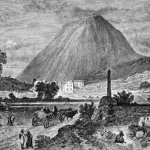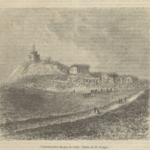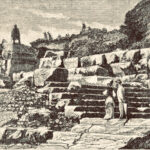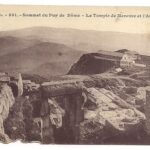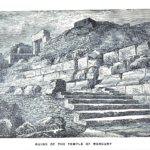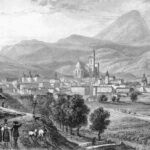Of course no one visits Clermont without making the ascent of the puy de Dôme.
-Matilda Betham-Edwards
The puy de Dôme — an Olympus in all but name — is arguably Auvergne’s most popular and most well-maintained natural site, attracting thousands of visitors annually. Even though technological innovations — such as the Panoramique des Dômes train — have made it more accessible in recent years, the mountain still seems like a land that time forgot. Picnic tables, information panels, a visitor centre; there are signs of civilisation all around, and yet there is something about the puy de Dôme that continues to feel refreshingly prehistoric and wild.
One wonders: did tourists in previous generations feel the same way? The answer is a resounding yes. Here’s an excerpt from “A Month in Auvergne” by the English writer, poet, and feminist Matilda Betham-Edwards (1836-1919). Betham-Edwards ascended the puy de Dôme in August 1879 and was blown away by her experience:
At eight o’clock we started in an open carriage, taking our breakfast with us, and both disposed to make the most of our day’s pleasure. What a wonderful drive is that from the volcanic-built city to the base of the great volcanoes which emitted flame and fire before the first cavemen were making their flint instruments in Dordogne! The time we have to go over in our minds before arriving at the life of these extinct volcanoes takes one’s breath away! It is supposed by some geologists that the great volcanic epoch of Central France was coeval with the formation of the Alps; and yet although the active period is lost in the past cycles of time, on every side we have traces of it; we might indeed from the scoria and cinders scattered about the base of the volcanoes imagine ourselves in the proximity of Mount Vesuvius.
On this uphill drive we soon get a fine view of Clermont, with its grand old cathedral rising proudly and gloomily above the city. Winding slowly upward amid cornfields, vineyards, and rocky banks, we gradually obtain a clearer view of the country, and the majestic outline of the puy de Dôme, with its twin dome, of which the proverb says—
“Si Dôme était sur Dôme,
On verrait les portes de Rome.”

It is a laborious two hours’ zigzag for the horses to the base of the mountain, each turn giving finer views of the volcanic ranges before us—the distant plain of La Limagne and far-away outlines of the dim Cévennes.
To my thinking these panoramic mountain ranges, today blue and vapoury as cloudland, are lovelier than Switzerland. On reaching the halting-place, we decided at once to mount; and all travellers here should follow our example, carrying their breakfast to the mountain top with them. By this arrangement the heat of the meridian sun and much extra fatigue is avoided. A superb climb we had, brilliant sunshine, cloudless sky, but a fresh, invigorating air.
The sides of the puy at this season are covered with a great variety of wild flowers, yellow foxgloves, the large yellow gentian, deliciously fragrant fringed dianthus of all shades, from the delicatest rose pink to the deepest rose, everywhere the air being sweet with them; then there are great varieties of exquisite heaths and campanulas, and lovely little deep orange potentillas and hawkweeds. Nothing is more delightful than to stand below one of the sharp ridges of the puy, rising boldly against the deep-blue sky; and from lofty summit to base, you see fringes of exquisite flowers, their fragility and brightness contrasting strikingly with the rugged sombreness and severity of the mountain. All around us lie masses of scoriæ, reminding us that we are among the great extinct volcanoes of Central France. Looking down on the line of the Dômes below, we see clearly enough the shape of the original craters, that of the puy de Pariou being conspicuous.

We bivouacked on a breezy hill-side, and breakfasted in the highest spirits, myself feeling no less frisky than my youthful companion. How well I remember the excellent flavour of the light wine alternately drunk from his folding leather drinking-cup! And the cold chicken and fruit and new bread, did ever such viands have so excellent a taste!
Meantime party after party of tourists followed us, and the broad summit soon wore the aspect of a vast picnic. The atmosphere was transparent enough for us to make out the different features of the wonderful panorama around us—the vast range of the Dômes, the Mont Dore and the Pic de Sancy towering above the rest; southward the Velay and the Cévennes, eastward the Jura range, westward Clermont with its environment of vine-clad hills and villages dotted here and there, farther westward still, the plain of Limagne. My companion told me that, when on this spot a few years before, he had found among the Roman ruins Gallo-Roman coins and fragments of pottery. Now nothing is to be obtained by the most persistent searcher. It is the geologist who will especially find interest and occupation here.
At the little restaurant attached to the State observatory, we saw a dozen or more superb St. Bernard dogs. These noble creatures enjoy entire indolence at this season of the year, but during the winter—which often lasts from September till April —they are occupied, as in Switzerland, with the rescue of snow-bound travellers.
Resting here a while, we talked of the great Pascal who at twelve worked out the problems of Euclid by himself, and on this spot made his tremendous discoveries; later in life to be “twice converted,” from which periods dated the gloom and sacerdotalism darkening his life and hastening his end. His mediævalism went so far that in his later years he wore a spiked girdle pressing into his flesh when tempted to pleasant thoughts!

Our descent after this halt was easy and pleasant enough, and we could afford to look with a superior air on those ill-advised travellers who had first stayed to breakfast below, and were now toiling upward in the heat of the day, hot and dispirited.
“Is it much higher?” they asked of us, as we jauntily skipped down, and we were bound to shake our heads solemnly and answer in the affirmative. At every turn we were obliged to pause and admire the delicate beauty of the mountain sides, velvety green, and fringed with the loveliest crimson and rose-coloured pinks, filling the air with fragrance.
On our arrival at the starting-place we found many family groups breakfasting under the trees. The ascent was evidently a favourite excursion, not only to the rich, but of all classes, some making it bravely on foot from Clermont.
I do not know why the puy de Dôme should be my favourite mountain, but so it is. Never did it look lovelier than when ten years later I looked back from the train on my way to Lyons, as with its sister volcanoes, pyramid upon pyramid of warm purple, it towered above the green Limagne; gradually the lower heights receded from view, at last nothing was left but that solitary dome of amethyst under the golden heaven.
For more tips on must-see attractions in Auvergne, click “Trip Ideas” below.




